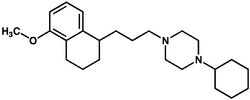Chemistry:PB-28
From HandWiki

| |
| Names | |
|---|---|
| IUPAC name
1-cyclohexyl-4-[3-(5-methoxy-1,2,3,4-tetra-
hydronaphthalen-1-yl)propyl]piperazine
| |
| Other names
PB28
| |
| Identifiers | |
| |
3D model (JSmol)
|
|
| ChEBI | |
| ChEMBL | |
| ChemSpider | |
| MeSH | C097775 |
PubChem CID
|
|
| UNII | |
| |
| |
| Properties | |
| C24H38N2O | |
| Molar mass | 370.57 g/mol |
Except where otherwise noted, data are given for materials in their standard state (at 25 °C [77 °F], 100 kPa). | |
| Infobox references | |
Tracking categories (test):
PB-28[1] is an agonist of the sigma-2 receptor.[2][3][4][5][6]
It is derived from cyclohexylpiperazine.
References
- ↑ "New sigma and 5-HT1A receptor ligands: omega-(tetralin-1-yl)-n-alkylamine derivatives". J. Med. Chem. 39 (1): 176–82. 1996. doi:10.1021/jm950409c. PMID 8568804.
- ↑ "The sigma-2 receptor agonist PB28 inhibits calcium release from the endoplasmic reticulum of SK-N-SH neuroblastoma cells". Cell Calcium 40 (1): 23–8. 2006. doi:10.1016/j.ceca.2006.03.004. PMID 16687172.
- ↑ "Cyclohexylpiperazine derivative PB28, a sigma2 agonist and sigma1 antagonist receptor, inhibits cell growth, modulates P-glycoprotein, and synergizes with anthracyclines in breast cancer". Mol. Cancer Ther. 5 (7): 1807–16. 2006. doi:10.1158/1535-7163.MCT-05-0402. PMID 16891467. http://mct.aacrjournals.org/content/molcanther/5/7/1807.full.pdf.
- ↑ "Is the sigma2 receptor a histone binding protein?". Journal of Medicinal Chemistry 49 (14): 4153–8. July 2006. doi:10.1021/jm0600592. PMID 16821775.
- ↑ "Exploring the importance of piperazine N-atoms for sigma(2) receptor affinity and activity in a series of analogs of 1-cyclohexyl-4-[3-(5-methoxy-1,2,3,4-tetrahydronaphthalen-1-yl)propyl]piperazine (PB28)". Journal of Medicinal Chemistry 52 (23): 7817–28. December 2009. doi:10.1021/jm9007505. PMID 19842660.
- ↑ "Interaction of the sigma(2) receptor ligand PB28 with the human nucleosome: computational and experimental probes of interaction with the H2A/H2B dimer". ChemMedChem 5 (2): 268–73. February 2010. doi:10.1002/cmdc.200900402. PMID 20077462.
External links
- PB28+compound at the US National Library of Medicine Medical Subject Headings (MeSH)
 |

